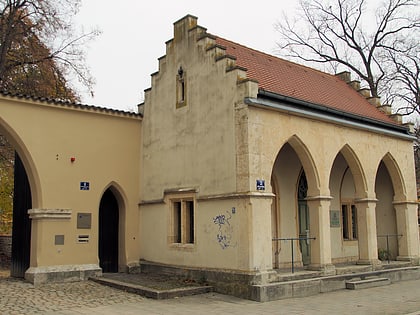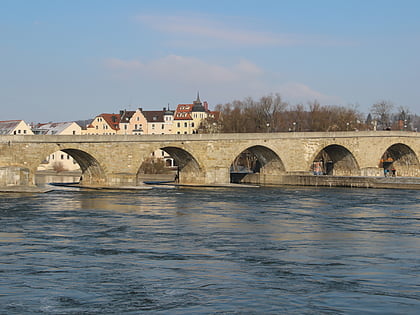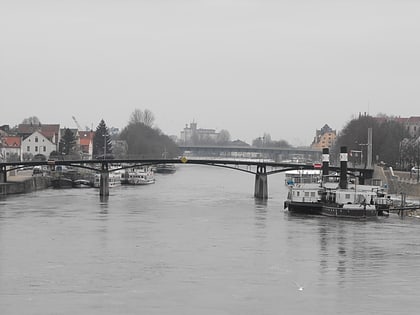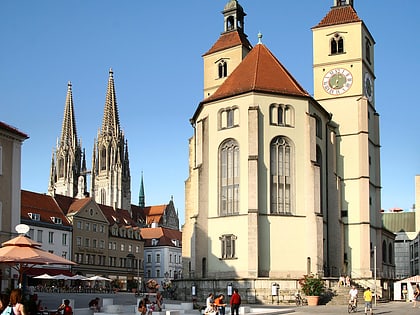Ostentor, Regensburg

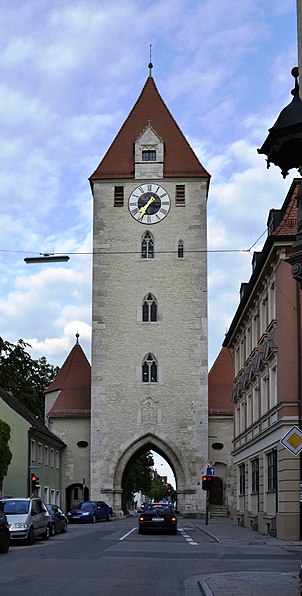
Facts and practical information
The Ostentor on the eastern edge of today's Old Town of Regensburg, built from 1284 onwards, was one of six gate towers of the former city fortifications and was erected to protect what was then known as the "Ostenvorstadt". The gate was built above the arterial road leading east to Vienna and was thus the city gate through which the respective emperor coming from Vienna entered the city. The gothic representative, five-story building was erected by members of the Regensburg cathedral building lodge according to discovered stonemason's marks and is today one of the best preserved gothic city gates in Germany.
The square tower, whose original crenellated flat roof only received its present tent roof in 1383, is flanked on the east side by two octagonal towers on either side. On both sides, pointed arches open the gateway, which leads through a gate hall with a ribbed cross bay. On both sides of the gate hall there are wall slots where the portcullis could be lowered with chains from the 1st floor of the tower. On the east side of the tower - the enemy side - at the level of the 2nd floor above the gateway there are porches resting on corbels, which served as cast-iron bays. On the upper floors there are embrasures and small lancet windows with tracery on both sides.
The east gate was included in the course of the city wall with its battlement, as a door on the south side on the 1st floor still makes clear. On the eastern enemy side, the East Gate was preceded by an armory with a tower and an adjoining fortification wall. There, the bridge led over the moat, which still today runs from the later built neo-Gothic gatekeeper's house to the north in the direction of the Danube. East of the Ostentor and the moat, the Ostenbastei was built in 1529/30, an elevated earthen embankment enclosed by walls and towers for the emplacement of guns. Today, the former bastion area is home to the Municipal Villa Park, which was created after 1667, after the completion of the Royal Villa to the east of the moat.
During the Thirty Years' War, when Regensburg was threatened with conquest by the Swedes in 1633, the East Gate was additionally protected by a hornwork erected in front of the city wall and moat.
When the Swedes besieged Regensburg in November 1633 during the Thirty Years' War and conquered it on November 15, there was an assault on the East Gate as early as November 8, during which a detachment under Lieutenant Colonel Nordhausen occupied the gate's drop bridge and was only prevented from entering the city by a gate. Due to a lack of powder, the attack failed and Nordhausen was killed. His body fell into the hands of the occupying Bavarian troops and was handed over to the city's ministry. His burial took place in the Envoy's Cemetery and was the first of several burials of high officers that took place there. The burial place has not been preserved.
The medieval gate guardhouse on the north side in front of the East Gate was replaced by a new building in the neo-Gothic style as early as 1840, 15 years before the construction of the neighboring Royal Villa to the north. The building is one of the few neo-Gothic architectural monuments in Regensburg and is registered in the list of architectural monuments in Regensburg
From 1903 to 1915, line 3 of the Regensburg tramway ran as far as the Ostentor and crossed the gate from 1915 to 1955 on its way to the Schlachthof terminus. This line provided access to the new eastern quarter with its industrial area and harbor, which was built after 1850 to the east of the Ostentor outside the old town. When, after the tramway was discontinued, the access road was widened to several lanes after 1960, the road ended in front of the narrow Ostentor, but there had already been plans since 1963 to go around the gate at the expense of the surrounding green spaces. All plans according to which the Ostentor was to be demolished or bypassed in favor of a car-friendly development of the old city of Regensburg were abandoned after 1980. In 2007, the Ostentor was extensively renovated inside and on the facade with funding from the Free State of Bavaria.
Ostentor – popular in the area (distance from the attraction)
Nearby attractions include: Stone Bridge, Regensburg Cathedral, Haus der Bayerischen Geschichte: Museum, Regensburg Arcaden.
Frequently Asked Questions (FAQ)
Which popular attractions are close to Ostentor?
How to get to Ostentor by public transport?
Bus
- Regensburg, Gabelsbergerstraße • Lines: 36, 37/820, 5050/5, 6072/810, 8B, N1 (3 min walk)
- Weißenburgstraße • Lines: 1, 10, 36, 37/820, 41, 41S, 42, 43;229, 5028/28, 5050/5, 51;451, 6072/810, 77, N1 (6 min walk)
Train
- Regensburg Hauptbahnhof (15 min walk)
